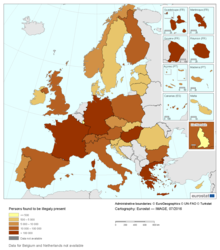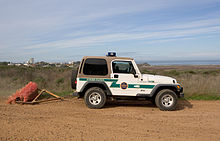Illegal immigration
![]()
This article or section needs revision. More details should be given on the discussion page. Please help improve it, and then remove this tag.
![]()
This article or paragraph presents the situation in Germany and the European Union. Help to describe the situation in other countries.
Illegal immigration (also illegal migration, irregular migration or undocumented immigration) refers to immigration in violation of the immigration laws of the destination country. Illegal residence refers to staying in a country without legal residency status. Entry and residence without valid identification documents or residence permits are punishable by law. Fines, imprisonment or deportation can be the consequence of illegal immigration or illegal residence. Policy measures to prevent illegal migration are diverse and range from tightening border controls to multilateral efforts to punish smuggling and/or improve the situation of individual countries and regions of origin. Refugees without valid visas may not be penalized for illegal immigration in countries that are parties to the Geneva Refugee Convention (GRC), provided they turn to the authorities immediately and the reason for flight is recognized in the subsequent asylum procedure. During the recognition process, a temporary residence permit applies.
The term illegal immigration is controversial; critical migration research recommends the use of the term 'irregular' or 'undocumented' (see section Critique of Terms).
In terms of the causes of illegal migration, a basic distinction is made between push and pull factors (or pressure and attraction factors). Push factors are, for example, poverty, unemployment or political reprisals in the home country, pull factors expectations of better living and working conditions and protection from political persecution in the destination country.

Non-EU citizens illegally residing in EU-28 and EFTA. Eurostat 2015
Death toll
According to press releases, 15,566 immigrants have died along the EU's external border since 1988, of which 6,513 bodies are still lost in the Mediterranean.
In the Mediterranean Sea, as well as in the Atlantic Ocean on the way to Spain, 10,989 people died. 4,205 drowned in the Channel of Sicily, between Libya, Tunisia, Malta and Italy, of whom 3,076 were lost; 140 more dead between Algeria and Sardinia, Italy. Another 4,534 dead between Morocco, Algeria, Mauritania, Senegal and Spain, crossing the Straits of Gibraltar or near the Canary Islands, of which 2,322 are missing. 1,369 dead in the Aegean Sea between Turkey and Greece, of which 824 are missing. 603 dead in the Adriatic Sea, between Albania, Montenegro and Italy, of which 220 are missing. In the Indian Ocean, 624 dead between the Comoros and the French island of Mayotte. But the sea is not only crossed by normal ships, but also hidden in transport cargos. In the process, 153 men suffocated or drowned.
The Sahara is a dangerous passage for migrants from sub-Saharan Africa to reach the Mediterranean. Migrants cross it in trucks and other vehicles between Sudan, Chad, Niger and Mali on their way to Libya and Algeria. At least 1,703 people have died here since 1996. The statistics also include the victims of mass deportations carried out by the authorities in Tripoli, Algeria and Rabat, where migrants are simply abandoned in desert-like border areas.
Serious mistreatment of migrants also occurs in Libya. There are no official figures, but in 2006 Human Rights Watch and Afvic Tripoli accused the country of arrests, beatings and torture in migrant centres. Of these centers, three are funded by Italy. At least 560 people died during violent mass riots against transmigrants in September 2000 in Zawiyah, in north-west Libya - Meanwhile, the EU has been negotiating a framework agreement with Libya since 2010, including on migration and visa issues.
360 people have already been found dead while travelling in lorries. 244 migrants have drowned while crossing border rivers, the majority of them at the Oder-Neisse border between Poland and Germany, in the Evros between Turkey and Greece, in the Sava between Croatia and Bosnia and in the Morava between Slovakia and the Czech Republic. 112 people froze to death on the way in the icy border areas in the mountains, this mainly in Turkey and Greece. At the Greek border with Turkey there are still minefields along the Evros River. At least 92 people have died here trying to cross into Greece.
265 migrants have been shot dead by border police, including 37 in Ceuta and Melilla, Spanish enclaves in Morocco, and 28 in the Van district in eastern Turkey near the Iranian border. Some people have also been shot by French, German, Spanish and Swiss police. 41 men have been found dead, hidden in the undercarriages of airplanes. 29 people have died in the Calais Jungle, or under trains in the Channel Tunnel trying to travel to England. Again, 12 have died under other trains to other borders and three have died trying to swim the English Channel.
Problems for government control
![]()
The neutrality of this article or section is disputed. A justification is on the discussion page. For more information, click here.
Illegal migration is becoming increasingly difficult for states to control, despite technically improved control options. Most states encourage and allow cross-border migratory movements, e.g. of business people, visitors and tourists. According to the Federal Border Guard Annual Report 2002, there were 436,580,484 travel movements across the German Schengen external borders.
Since the EU's eastward enlargement, crossing the green border without permission has become increasingly unattractive because of the ever-increasing costs and the ever-increasing risk of being tracked down by the border police with the help of high-tech equipment, then arrested and deported back. The situation is comparable at the Blue Border, i.e. the sea route, as evidenced by the unabatedly high number of deaths in the Mediterranean.
See also: Border regime

Smoothing the ground at the U.S.-Mexico border to make footprints visible
Questions and Answers
Q: What is an illegal immigrant?
A: An illegal immigrant is an immigrant who lives in a country without permission or in a way that is not allowed, or illegal.
Q: How many people around the world live in another country against the laws of that country?
A: Millions of people around the world live in another country against the laws of that country.
Q: How do many illegal immigrants migrate to a country?
A: Many illegal immigrants migrate to a country in secret.
Q: How do some illegal immigrants come to a country?
A: Some illegal immigrants come to the country legally as a visitor, then stay in the country when they should legally be going home.
Q: What do some illegal immigrants do when they are in a country illegally?
A: Some illegal immigrants work illegally and live in bad conditions.
Q: Why do illegal immigrants usually move to a country?
A: They usually move for similar reasons as other immigrants, but they do not legally have the right to be there.
Q: Is it legal to live in a country without permission or in a way that is not allowed?
A: No, it is not legal to live in a country without permission or in a way that is not allowed.
Search within the encyclopedia